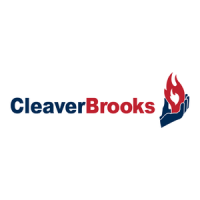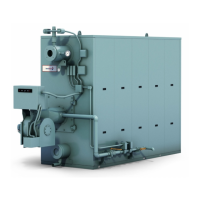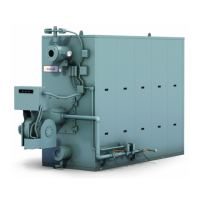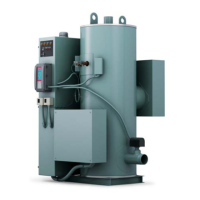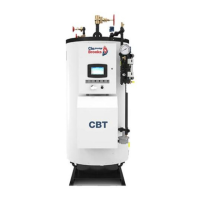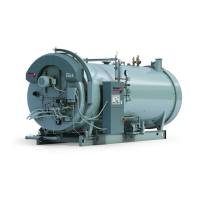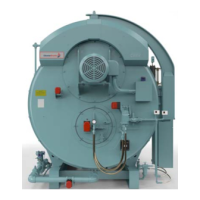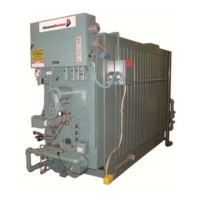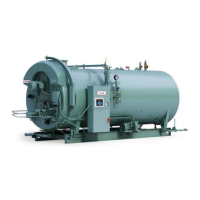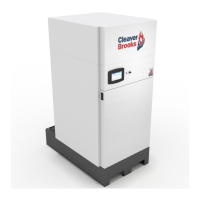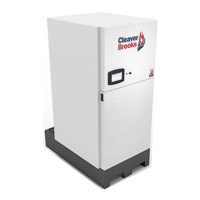Profire V Burner Chapter 2
750-177 2-17
C. Startup and Operation
When the installation is complete and all electrical, fuel,
water, and vent stack connections are made, make certain the
connections are tight. The operator should become familiar
with the burner, boiler controls and components. To identify
controls and components, refer to drawings and contents of
Section 1. Adjustment procedures given in Section 4 should
be reviewed prior to firing. The wiring diagram should also
be studied along with the operating sequence of the burner
programmer. Check the electrical power supply for
accordance with the nameplate specifications for all motors
and controls.
Read and understand starting instructions before attempting
to operate the burner. The following checks must be made:
BOILER
Check boiler water level. Be sure all boiler valves are
installed correctly and positioned properly. Set the high limit
control slightly above the operating control. Set operating
control at the desired temperature or pressure.
BURNER
For protection in shipment, the flame safeguard control
chassis is shipped unmounted. Check all screw connections
before attaching flame safeguard chassis to base. The screw
must be secure to assure low resistance connections. The
relay chassis is mounted on the subbase with a screw which,
when tightened, completes the connection between the
subbase and chassis contacts. Press manual reset button to be
sure safety switch contacts are closed.
Check fuses in main panel and in the burner control cabinet.
Check wiring to the burner control cabinet for compliance
with the wiring diagram and local codes. The control cabinet
components are 120 volt. If a control transformer is supplied,
ensure that the supply voltage matches its primary voltage.
Check motor rotation by momentarily closing the starter or
relay. Blower rotation is clockwise when viewed from the
drive end.
Check the pilot electrode setting. Refer to the Adjustment
section.
Check control linkage for proper movement of the air volume
damper and fuel metering components. This can be done by
loosening the linkage at the actuator lever and manipulating
by hand.
Check the air shutter and adjust low-fire setting. Refer to the
Adjustment setting.
FIRING PREPARATIONS
Check to make certain that all plugs, connections. linkages,
etc., are tight. Prior to initial firing, oil flow and pressure
should be verified.
GAS BURNERS
A representative of the gas utility should turn on the gas.
Determine by a test gauge upstream of the burner regulator
that sufficient pressure exists at the entrance to the gas train.
The gas pressure regulator must be adjusted to the pressure
required and the pressure setting recorded.
On combination fuel models, set the selector switch to gas.
On initial startup it is recommended that the main gas shutoff
cock remain closed until the programmer has cycled through
pre-purge and pilot sequences to determine that the main gas
valve opens. Turn the burner switch OFF and let the
programmer finish its cycle. Check to see that the gas valve
closes tightly.
On burners equipped with high and low gas pressure
switches, set switch pressure actuating levels and record
settings for future service reference.
See the burner specification nameplate inside the control
panel door for minimum and maximum input rate and
required manifold pressure.
When the conditions covered above and in Section 2 are
assured, the burner is ready for firing. Refer to Section E for
starting and operating information.
OIL BURNERS
Prior to initial firing, oil flow and pressure should be verified.
If the burner is a dual fuel model, make certain that the main
gas shutoff cock is closed and the fuel selector switch is set to
OIL.
OIL FLOW
If the oil supply tank is below the level of the oil fuel unit, it
is recommended that the suction line be primed with oil prior
to starting the pump to avoid the possibility of damage to the
pump through operation without lubrication.
To check for proper pump rotation, momentarily energize the
starter. With rotation verified, operate the pump to determine
that oil circulation exists. Observe the oil burner pressure
gauge. If not pressure shows after a few moments, stop the oil
pump and re-prime. If the supply tank is lower than the pump,
it is possible that the initial priming of the suction line,
followed by operation of the pump, will not establish oil flow.
This might be caused by obstruction in the suction line,
excessive lift, inadequate priming, suction line leaks, etc.
Until oil flow is established, avoid prolonged operation of the
pump. If oil flow is not established after a second priming,
investigation is required.
A vacuum (or compound pressure-vacuum) gauge should be
installed at the suction port of the pump. It is advisable that
the reading be less than 15” Hg vacuum. Vacuum in excess of
this may cause unstable firing.
